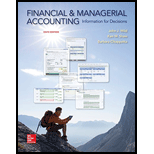
Financial and Managerial Accounting: Information for Decisions
6th Edition
ISBN: 9780078025761
Author: John J Wild, Ken Shaw Accounting Professor, Barbara Chiappetta Fundamental Accounting Principles
Publisher: McGraw-Hill Education
expand_more
expand_more
format_list_bulleted
Concept explainers
Textbook Question
Chapter 24, Problem 3DQ
Identify four reasons that capital budgeting decisions are risky.
Expert Solution & Answer
Want to see the full answer?
Check out a sample textbook solution
Students have asked these similar questions
Net sales for this period
The company's total assets are?
Provide correct answer general Accounting question
Chapter 24 Solutions
Financial and Managerial Accounting: Information for Decisions
Ch. 24 - Prob. 1MCQCh. 24 - Prob. 2MCQCh. 24 - Prob. 3MCQCh. 24 - Prob. 4MCQCh. 24 - Prob. 5MCQCh. 24 - Prob. 1DQCh. 24 - What is capital budgeting?Ch. 24 - Identify four reasons that capital budgeting...Ch. 24 - Prob. 4DQCh. 24 - Prob. 5DQ
Ch. 24 - Prob. 6DQCh. 24 - Prob. 7DQCh. 24 - Prob. 8DQCh. 24 - Prob. 9DQCh. 24 - Prob. 10DQCh. 24 - Prob. 11DQCh. 24 - Prob. 12DQCh. 24 - Prob. 13DQCh. 24 - Prob. 1QSCh. 24 - Prob. 2QSCh. 24 - Prob. 3QSCh. 24 - QS 24-4 Analyzing payback periods P1
Howard Co. is...Ch. 24 - Prob. 5QSCh. 24 - Prob. 6QSCh. 24 - Prob. 7QSCh. 24 - Prob. 8QSCh. 24 - Prob. 9QSCh. 24 - Prob. 10QSCh. 24 - Prob. 11QSCh. 24 - Prob. 12QSCh. 24 - Prob. 13QSCh. 24 - Prob. 14QSCh. 24 - Prob. 15QSCh. 24 - Prob. 16QSCh. 24 - Prob. 1ECh. 24 - Exercise 24-2 Net present value P3 Refer to the...Ch. 24 - Prob. 3ECh. 24 - Prob. 4ECh. 24 - Prob. 5ECh. 24 - Prob. 6ECh. 24 - Prob. 7ECh. 24 - Prob. 8ECh. 24 - Prob. 9ECh. 24 - Prob. 10ECh. 24 - Prob. 11ECh. 24 - Prob. 12ECh. 24 - Prob. 13ECh. 24 - Prob. 14ECh. 24 - Prob. 15ECh. 24 - Prob. 16ECh. 24 - Prob. 1PSACh. 24 - Prob. 2PSACh. 24 - Prob. 3PSACh. 24 - Prob. 4PSACh. 24 - Prob. 5PSACh. 24 - Prob. 6PSACh. 24 - Prob. 1PSBCh. 24 - Prob. 2PSBCh. 24 - Prob. 3PSBCh. 24 - Prob. 4PSBCh. 24 - Prob. 5PSBCh. 24 - Prob. 6PSBCh. 24 - Prob. 24SPCh. 24 - Prob. 1BTNCh. 24 - Prob. 2BTNCh. 24 - Prob. 3BTNCh. 24 - Prob. 4BTNCh. 24 - Prob. 5BTNCh. 24 - Break into teams and identify four reasons that an...Ch. 24 - Prob. 7BTNCh. 24 - Prob. 8BTNCh. 24 - Prob. 9BTN
Knowledge Booster
Learn more about
Need a deep-dive on the concept behind this application? Look no further. Learn more about this topic, accounting and related others by exploring similar questions and additional content below.Similar questions
- Hii expert please given true answer general Accountingarrow_forwardOn December 31, Year 8, Suzi McDowell wants to have $60,000. She plans to make 6 deposits in a fund to provide this amount. Interest compounds annually at 12%. Required: Compute the equal annual amounts that Suzi must deposit assuming that he makes the first deposit on: December 31, Year 3 December 31, Year 2arrow_forwardHello tutor please help me this questionarrow_forward
- correct answer pleasearrow_forwardhi expert please help mearrow_forwardE14.10 (LO 1) (Information Related to Various Bond Issues) Pawnee Inc. has issued three types of debt on January 1, 2022, the start of the company's fiscal year. a. $10 million, 10-year, 13% unsecured bonds, interest payable quarterly. Bonds were priced to yield 12%. b. $25 million par of 10-year, zero-coupon bonds at a price to yield 12% per year. c. $15 million, 10-year, 10% mortgage bonds, interest payable annually to yield 12%. Instructions Prepare a schedule that identifies the following items for each bond: (1) maturity value, (2) number of interest periods over life of bond, (3) stated rate per each interest period, (4) effective-interest rate per each interest period, (5) payment amount per period, and (6) present value of bonds at date of issue. Hint: you don't need to prepare the amortization schedule to answer this question. Just a simple table is enough.arrow_forward
arrow_back_ios
SEE MORE QUESTIONS
arrow_forward_ios
Recommended textbooks for you
 Intermediate Financial Management (MindTap Course...FinanceISBN:9781337395083Author:Eugene F. Brigham, Phillip R. DavesPublisher:Cengage Learning
Intermediate Financial Management (MindTap Course...FinanceISBN:9781337395083Author:Eugene F. Brigham, Phillip R. DavesPublisher:Cengage Learning EBK CONTEMPORARY FINANCIAL MANAGEMENTFinanceISBN:9781337514835Author:MOYERPublisher:CENGAGE LEARNING - CONSIGNMENT
EBK CONTEMPORARY FINANCIAL MANAGEMENTFinanceISBN:9781337514835Author:MOYERPublisher:CENGAGE LEARNING - CONSIGNMENT

Intermediate Financial Management (MindTap Course...
Finance
ISBN:9781337395083
Author:Eugene F. Brigham, Phillip R. Daves
Publisher:Cengage Learning

EBK CONTEMPORARY FINANCIAL MANAGEMENT
Finance
ISBN:9781337514835
Author:MOYER
Publisher:CENGAGE LEARNING - CONSIGNMENT

Financial Risks - Part 1; Author: KnowledgEquity - Support for CPA;https://www.youtube.com/watch?v=mFjSYlBS-VE;License: Standard youtube license